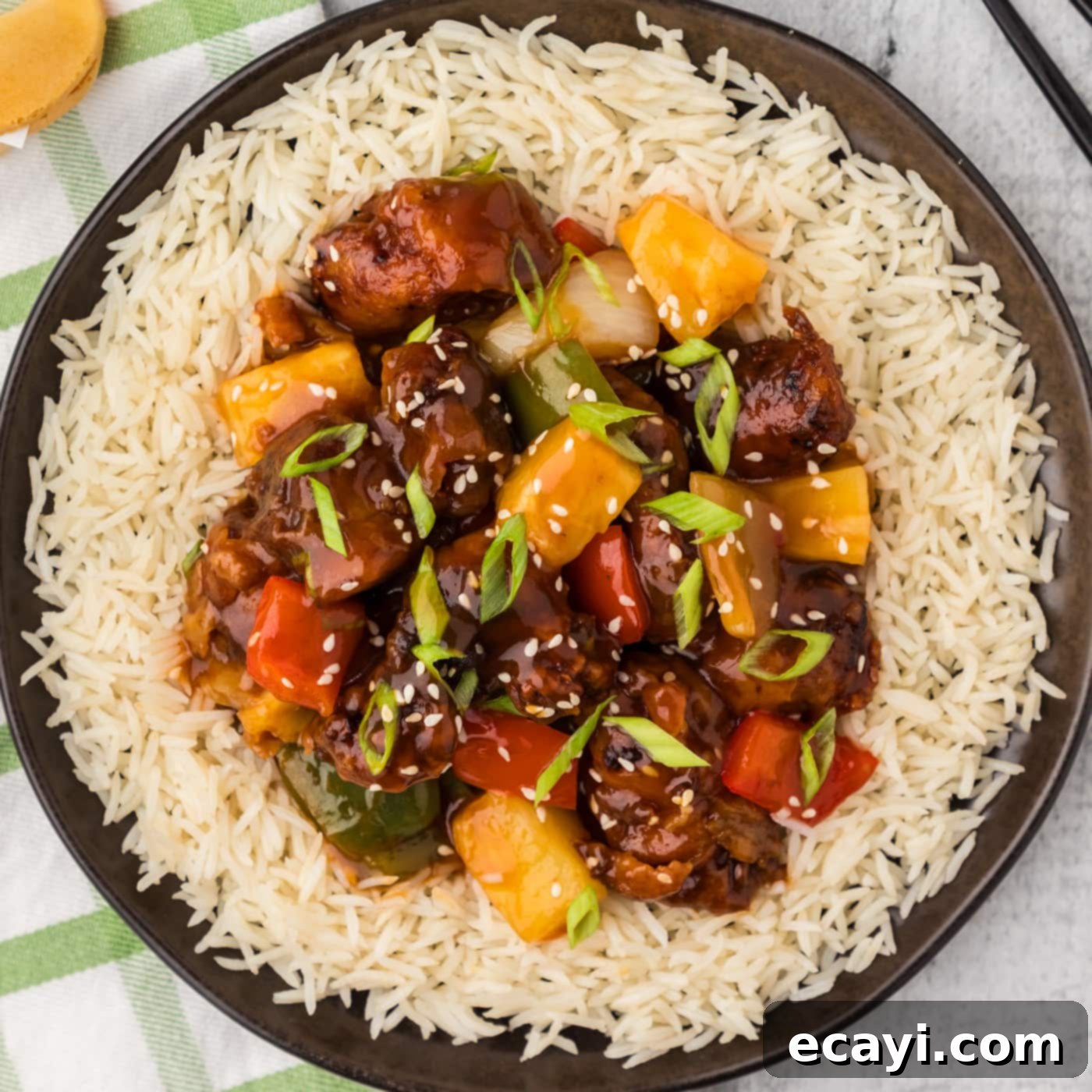Authentic Sweet and Sour Pork: Your Guide to a Crispy, Tangy, and Flavorful Takeout Favorite at Home
There’s a reason sweet and sour pork remains a beloved classic on Chinese restaurant menus worldwide. It’s a symphony of textures and flavors – succulent, crispy pieces of pork enveloped in a vibrant, sticky sauce, punctuated by crisp-tender vegetables and juicy pineapple. This iconic dish offers a delightful balance of savory, sweet, and tangy notes that tantalize the taste buds. Forget ordering takeout; with this comprehensive recipe, you can recreate that irresistible restaurant-quality experience right in your own kitchen. Prepare for a stir-fry adventure that’s bursting with color, aroma, and unforgettable taste.

Why This Sweet and Sour Pork Recipe is a Must-Try
What sets this sweet and sour pork recipe apart and makes it truly special? It all comes down to the perfect harmony of textures and the vibrant, homemade sauce. We start with tender cuts of pork, meticulously breaded and fried to a beautiful golden crisp. While it’s true that any crispy, sauced dish will eventually soften, this recipe is designed to deliver that ideal “crispy-meets-saucy” moment. The breading absorbs just enough of the glorious sweet and sour sauce to become tender and flavorful, without turning soggy, especially when enjoyed fresh off the wok. This creates an incredibly satisfying mouthfeel that’s genuinely addictive.
Beyond the delightful texture, the star of the show is undeniably our homemade sweet and sour sauce. Unlike many store-bought varieties that can be overly sweet or artificial, our sauce is crafted from scratch using a balanced blend of honey, soy sauce, tomato paste, pineapple juice, and rice vinegar. This combination yields a complex flavor profile that is tangy, sweet, and deeply savory, providing the authentic taste you crave. Dotted with colorful stir-fried bell peppers, onions, and sweet pineapple chunks, every bite is an explosion of fresh ingredients and delightful contrast. This isn’t just a meal; it’s a culinary experience that brings the joy and flavor of your favorite Chinese takeout right to your dining table, proving that homemade truly is best.
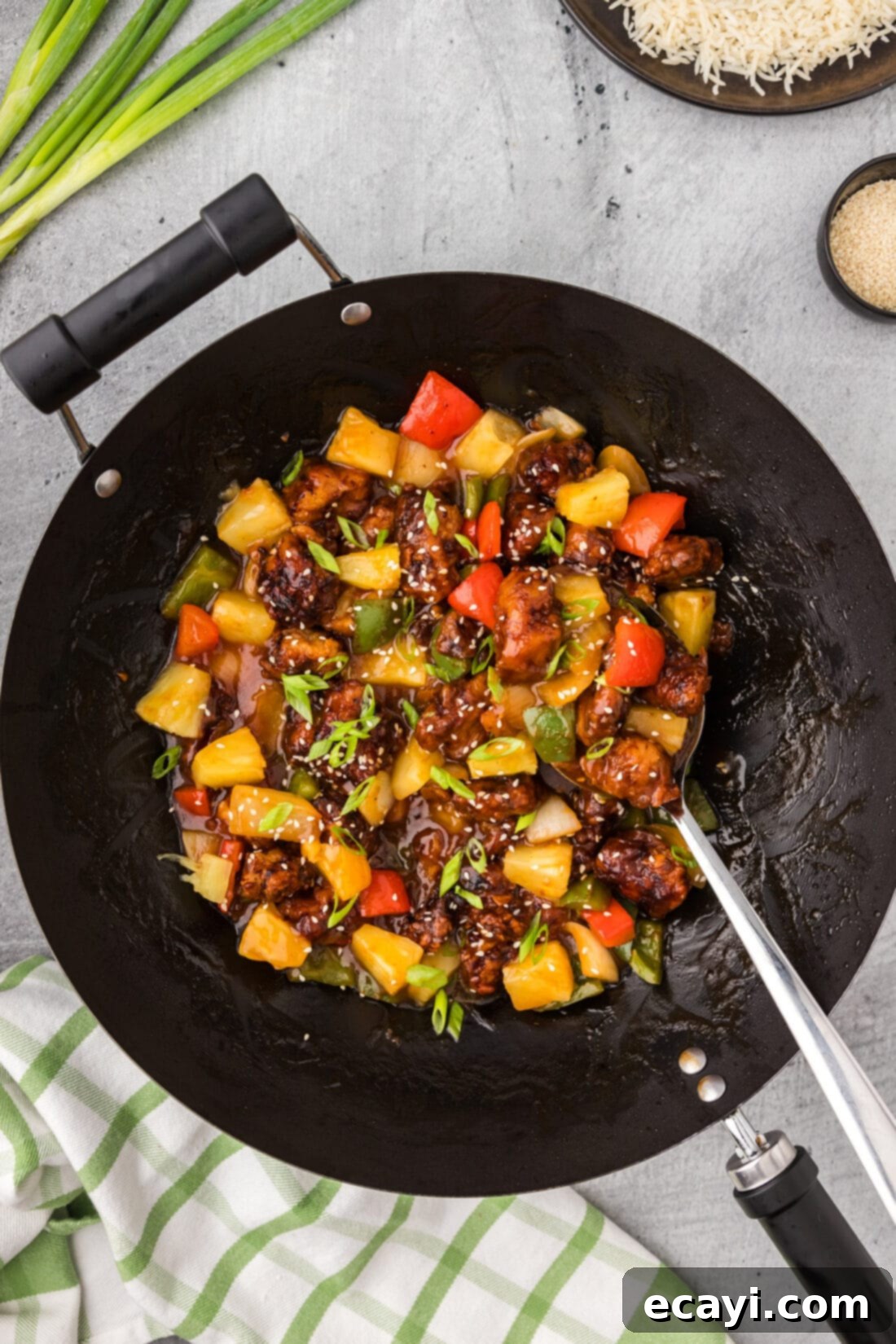
Gather Your Ingredients for This Delicious Stir-Fry
Creating this incredible sweet and sour pork dish requires a selection of fresh, high-quality ingredients that work together to build its signature flavor profile. From the succulent pork to the vibrant vegetables and the irresistible homemade sauce, each component plays a crucial role. While the full, precise measurements and step-by-step instructions are available in the printable recipe card at the end of this post, here’s a breakdown of what you’ll need to get started:
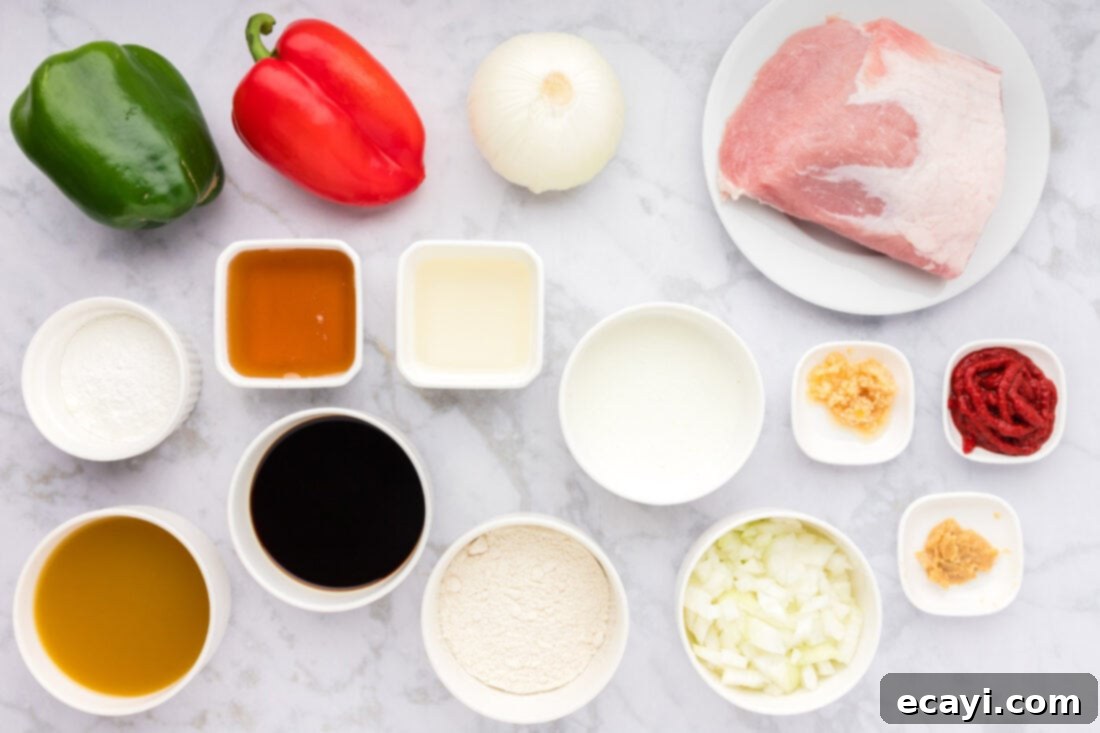
- For the Pork: Boneless pork loin center cut roast.
- For the Marinade: Chopped onion, minced garlic, minced ginger, and soy sauce.
- For the Sweet and Sour Sauce: Honey, soy sauce, tomato paste, pineapple juice, rice vinegar, cornstarch, and water (for the slurry).
- For the Breading: All-purpose flour (divided), buttermilk, and vegetable oil (for frying).
- For the Stir-Fry Vegetables: Olive oil, medium onion (chopped into large chunks), large green bell pepper (chopped into large chunks), large red bell pepper (chopped into large chunks), and pineapple chunks.
Having all your ingredients prepped and ready before you begin cooking (mise en place) will make the stir-frying process much smoother and more enjoyable, allowing you to focus on the technique and achieve the best results.
Ingredient Information and Expert Substitution Suggestions
Understanding each ingredient’s role and knowing suitable substitutions can empower you to customize this sweet and sour pork recipe to your preference or dietary needs. Here’s a deeper dive into the key components:
PORK: We’ve opted for pork loin center cut roast in this recipe due to its lean nature and tender texture when cooked correctly. However, other cuts like pork neck or pork shoulder (also known as pork butt) are excellent alternatives. These cuts tend to have a bit more fat marbling, which can result in even juicier and more flavorful pieces after frying. Regardless of the cut, the key is to ensure the pork is trimmed of excess fat and cut into similar-sized, bite-sized cubes. This promotes even cooking, ensuring every piece is perfectly done at the same time.
MARINADE: Our quick marinade infused with onion, garlic, ginger, and soy sauce is crucial for tenderizing the pork and adding a foundational layer of savory flavor. If you don’t have fresh ginger, a good quality ground ginger can be used, but fresh is always preferred for its vibrant aroma. For a gluten-free option, substitute regular soy sauce with tamari. This marinade is short but effective, preparing the pork beautifully for the breading and frying process.
SWEET AND SOUR SAUCE: The heart and soul of this dish is undoubtedly the homemade sweet and sour sauce. It’s a masterful blend of five core flavors: sweet (honey, pineapple juice), sour (rice vinegar, pineapple juice), salty (soy sauce), umami (soy sauce, tomato paste), and a touch of richness (tomato paste).
- Honey: Provides a natural sweetness and glossy finish. You can substitute with brown sugar or maple syrup for a slightly different flavor profile.
- Soy Sauce: Adds a fundamental savory, umami depth. Use low-sodium soy sauce to control salt levels, or tamari for a gluten-free version.
- Tomato Paste: Contributes color, a subtle tang, and body to the sauce. Don’t skip this for authentic flavor. Ketchup is sometimes used in older recipes, but tomato paste offers a cleaner, less sugary tomato flavor.
- Pineapple Juice: Crucial for the fruity tang and sweetness. Ensure it’s unsweetened for best results. Orange juice can be a last-resort substitute, but pineapple juice is preferred.
- Rice Vinegar: Provides the essential sour component. Apple cider vinegar can be used in a pinch, but rice vinegar has a milder, cleaner acidity.
- Cornstarch Slurry: This is what thickens the sauce to that perfect sticky consistency. Always mix cornstarch with cold water before adding it to hot liquid to prevent lumps. Arrowroot powder is a suitable alternative for thickening.
If you find yourself with extra sauce, it’s incredibly versatile and makes a fantastic glaze or dipping sauce for chicken nuggets, shrimp, or even spring rolls. You can easily adjust the quantity of sauce by halving the ingredients if you prefer less.
BREADING: The classic breading technique involves a simple flour dredge followed by a buttermilk dip, and then a second flour dredge. This two-stage process ensures a thick, even coating that fries up wonderfully crispy. Buttermilk is excellent for tenderizing and adhering the flour, but if you don’t have it, you can make a quick substitute by adding 1 tablespoon of white vinegar or lemon juice to regular milk and letting it sit for 5-10 minutes until it slightly curdles. For a lighter breading, some recipes use a simple cornstarch coating, but the flour and buttermilk combo delivers that signature crispy texture.
STIR-FRY VEGETABLES: Onions, green bell peppers, and red bell peppers add vibrant color, a pleasant crunch, and a fresh counterpoint to the rich pork and sauce.
- Bell Peppers: Feel free to use yellow or orange bell peppers as well for even more color. Cut them into similar-sized large chunks so they cook evenly and retain a slight bite.
- Onion: Large chunks work best here, as they soften but don’t disappear into the sauce.
- Pineapple Chunks: Fresh or canned pineapple chunks (drained) are essential for that sweet, tropical burst that perfectly complements the sauce.
Other vegetables like carrots, snap peas, or water chestnuts can also be added for extra crunch and nutrition. Remember to cut all vegetables to a similar size for even cooking during the quick stir-fry.
Step-by-Step Guide: How to Make Sweet and Sour Pork at Home
These step-by-step photos and instructions are here to help you visualize how to make this recipe. You can Jump to Recipe to get the printable version of this recipe, complete with measurements and instructions at the bottom.
Making delicious sweet and sour pork at home is a rewarding process that comes together in a few distinct stages: marinating the pork, preparing the sauce, breading and frying, and finally, the stir-fry. Follow these steps for an outstanding result:
Marinate the Meat
- Prepare the Pork: Begin by cutting your boneless pork loin roast into uniform, bite-sized cubes. Aim for pieces roughly 1-inch in size for even cooking. Place the cubed pork into a large mixing bowl.
- Create the Marinade: In a separate container suitable for an immersion blender (or a regular blender), combine the chopped onion, minced garlic, minced ginger, and soy sauce. Blend the mixture until it forms a smooth paste with no large chunks remaining. This ensures the flavors are fully incorporated and evenly coat the pork.
- Marinate the Pork: Pour the freshly blended marinade over the pork cubes in the mixing bowl. Using gloved hands, toss the meat thoroughly to ensure every piece is completely coated. Cover the bowl tightly with plastic wrap and place it in the refrigerator. Allow the pork to marinate for at least 30 minutes. This step is crucial for infusing the pork with flavor and beginning the tenderizing process.
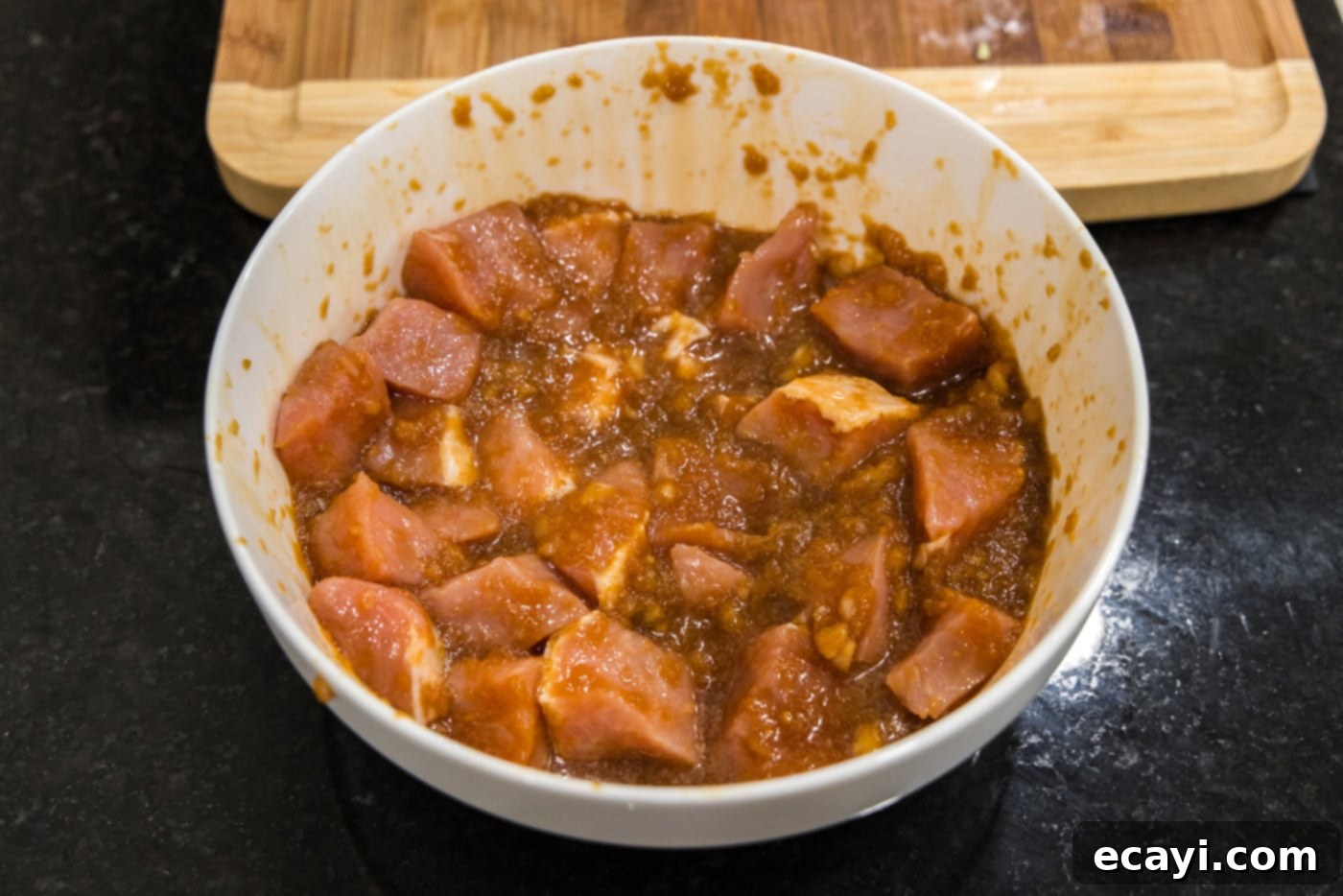
Preparing the Sweet and Sour Sauce
- Set Up for Frying (Optional but Recommended): While the pork marinates, prepare a landing spot for your fried pork. Line a baking sheet with several layers of paper towels and place a wire cooling rack directly over the top. This setup will allow excess oil to drain from the fried pork, helping it stay crispy.
- Cook the Sauce: In a medium saucepan, combine all the sweet and sour sauce ingredients EXCEPT for the cornstarch and water (these are for the slurry). Whisk the ingredients together until well combined. Place the saucepan over medium-high heat and bring the mixture to a gentle bubble, whisking occasionally. This process allows the flavors to meld and deepen.
- Thicken the Sauce: While the sauce is bubbling, prepare a cornstarch slurry by whisking the cornstarch with ¼ cup of cold water until smooth. Slowly pour this slurry into the bubbling sauce in the saucepan, whisking continuously. Continue to whisk occasionally as the sauce cooks until it thickens to your desired consistency – typically a sticky, glossy texture that coats the back of a spoon. Once thickened, immediately turn off the heat to prevent it from becoming too thick. Set the sauce aside.
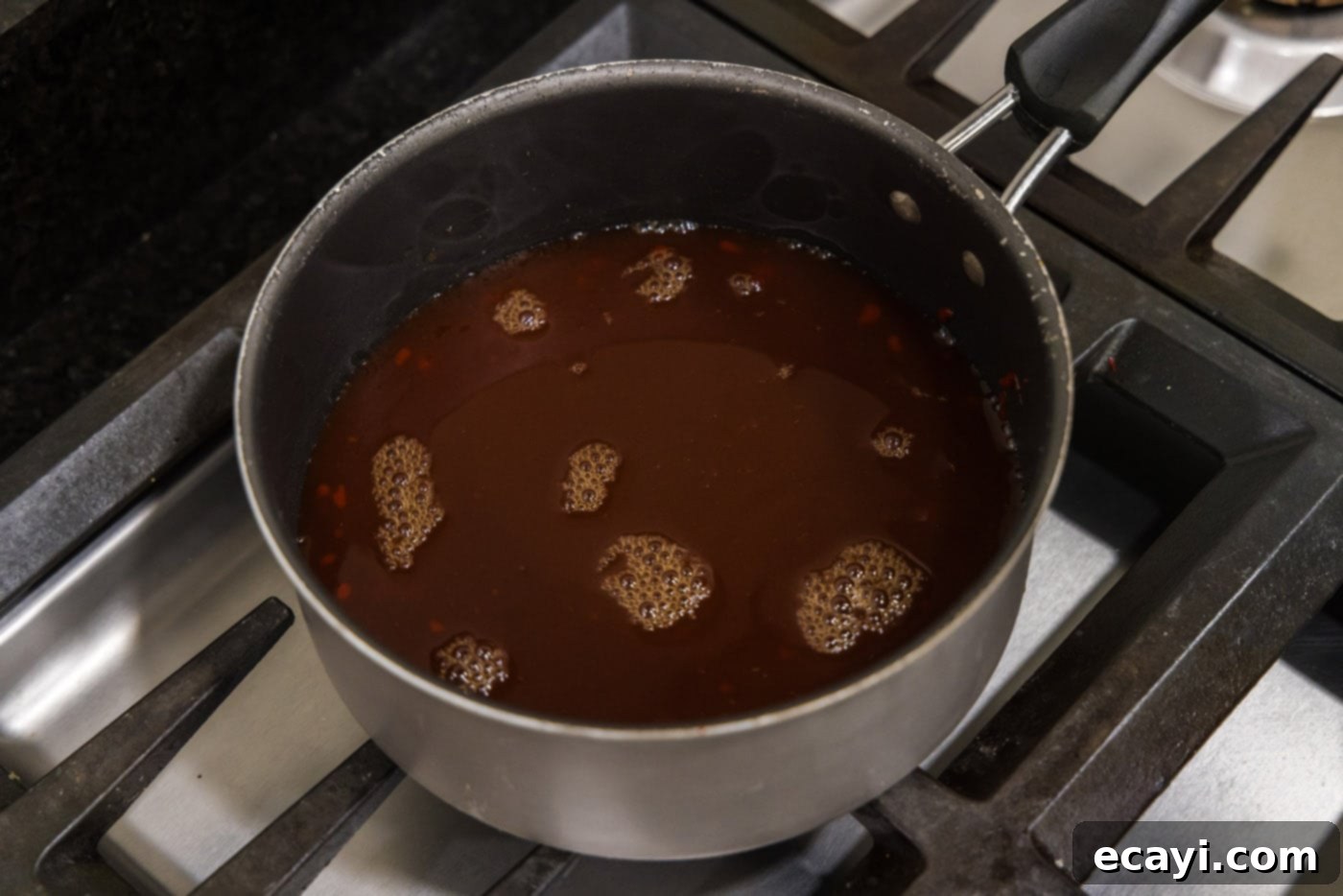
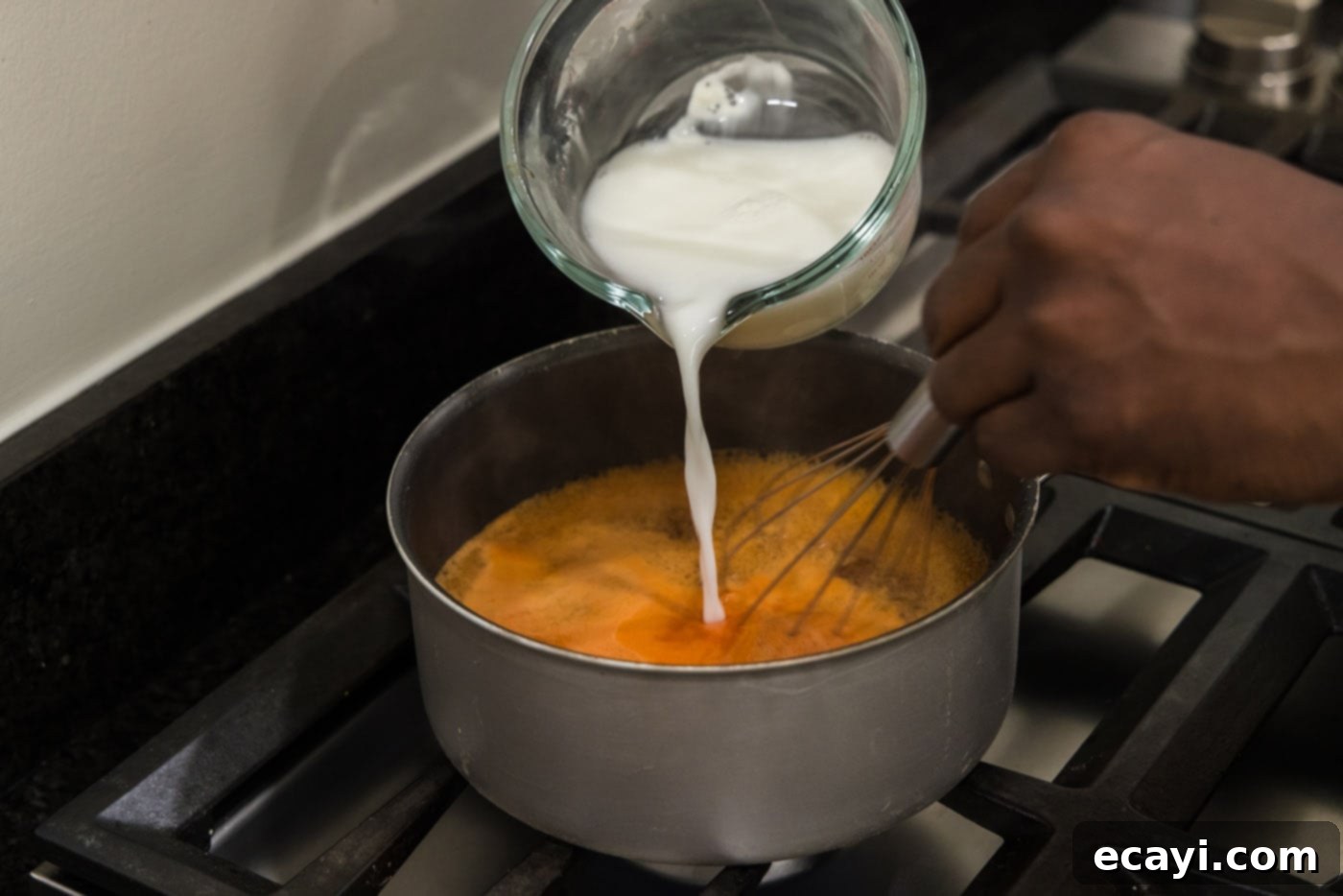
Breading and Frying the Pork
- First Flour Dredge: Remove the marinated pork from the refrigerator. Sprinkle about 2 tablespoons of the all-purpose flour over the pork in the mixing bowl. Use gloved hands to toss the pork, ensuring it’s lightly coated. This initial flour layer helps the buttermilk adhere better.
- Set Up Breading Station: Prepare a simple dipping station. Pour the buttermilk into a medium bowl, and spread the remaining flour evenly on a plate or in a shallow dish.
- Breading the Pork: Take one piece of pork at a time. First, dip it into the buttermilk, allowing any excess to drip off. Then, immediately dredge it thoroughly in the flour, pressing lightly to ensure a full and even coating. Place the breaded pork piece aside and continue this process with all the remaining pork cubes until they are fully breaded.
- Heat the Oil: Pour enough vegetable oil into a deep, heavy-bottomed pot or Dutch oven to reach about 2-3 inches in depth. Heat the oil over medium-high heat until it reaches 325°F (160°C). Use a kitchen thermometer to ensure accuracy. If you don’t have a thermometer, a small drop of flour should sizzle gently upon contact with the oil.
- Fry the Pork: Carefully add the breaded pork pieces to the hot oil, one by one, ensuring not to overcrowd the pan. Fry the pork in batches if necessary to maintain consistent oil temperature. Fry for 3-4 minutes until the pork is golden brown and cooked through. Using tongs, turn the pieces over halfway through cooking to ensure even browning.
- Drain the Pork: Once fried to perfection, carefully remove the crispy pork pieces from the oil using tongs or a slotted spoon. Transfer them immediately to the prepared wire cooling rack on the baking sheet to drain off any excess oil. This helps maintain their crispiness while you proceed to the next step.
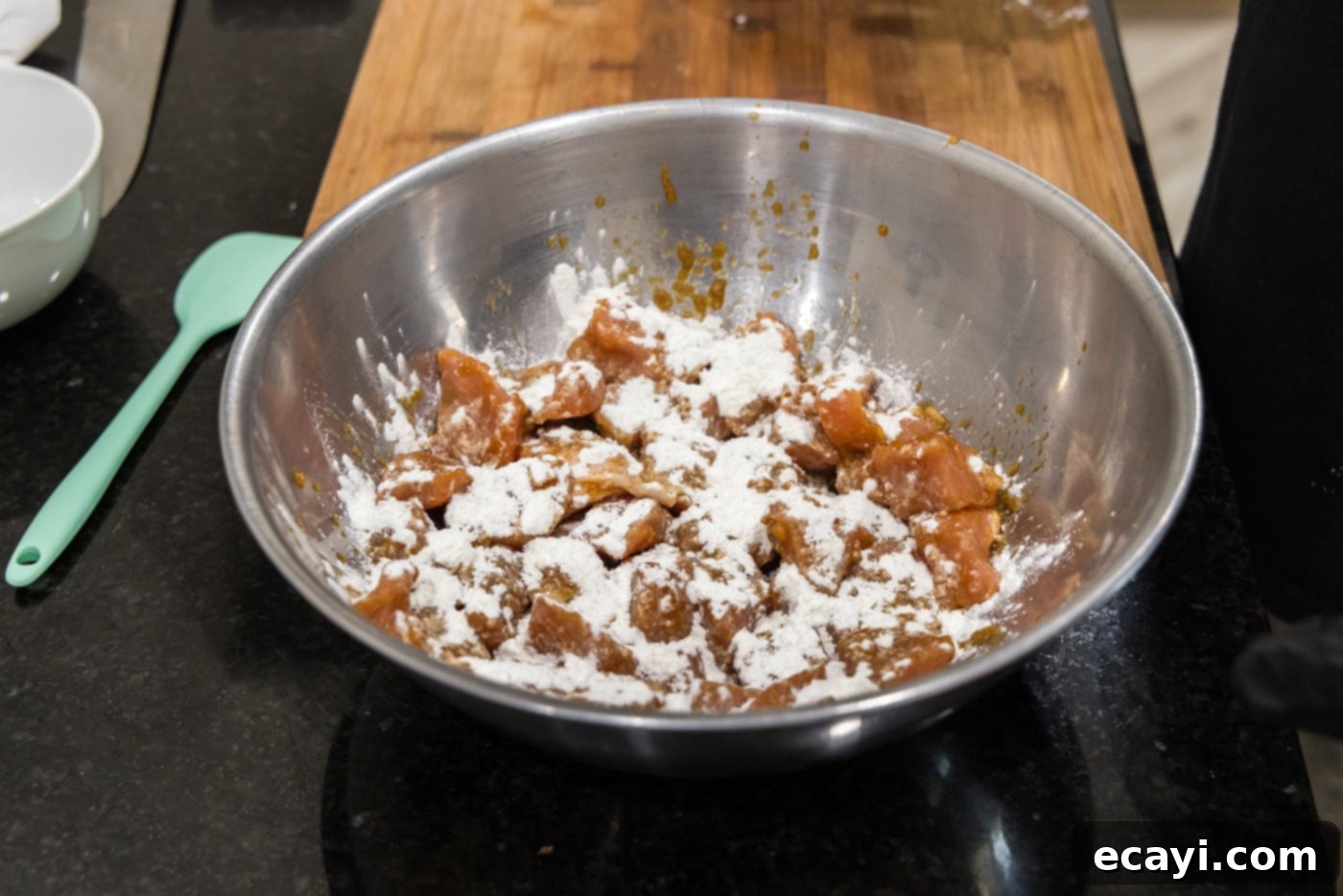
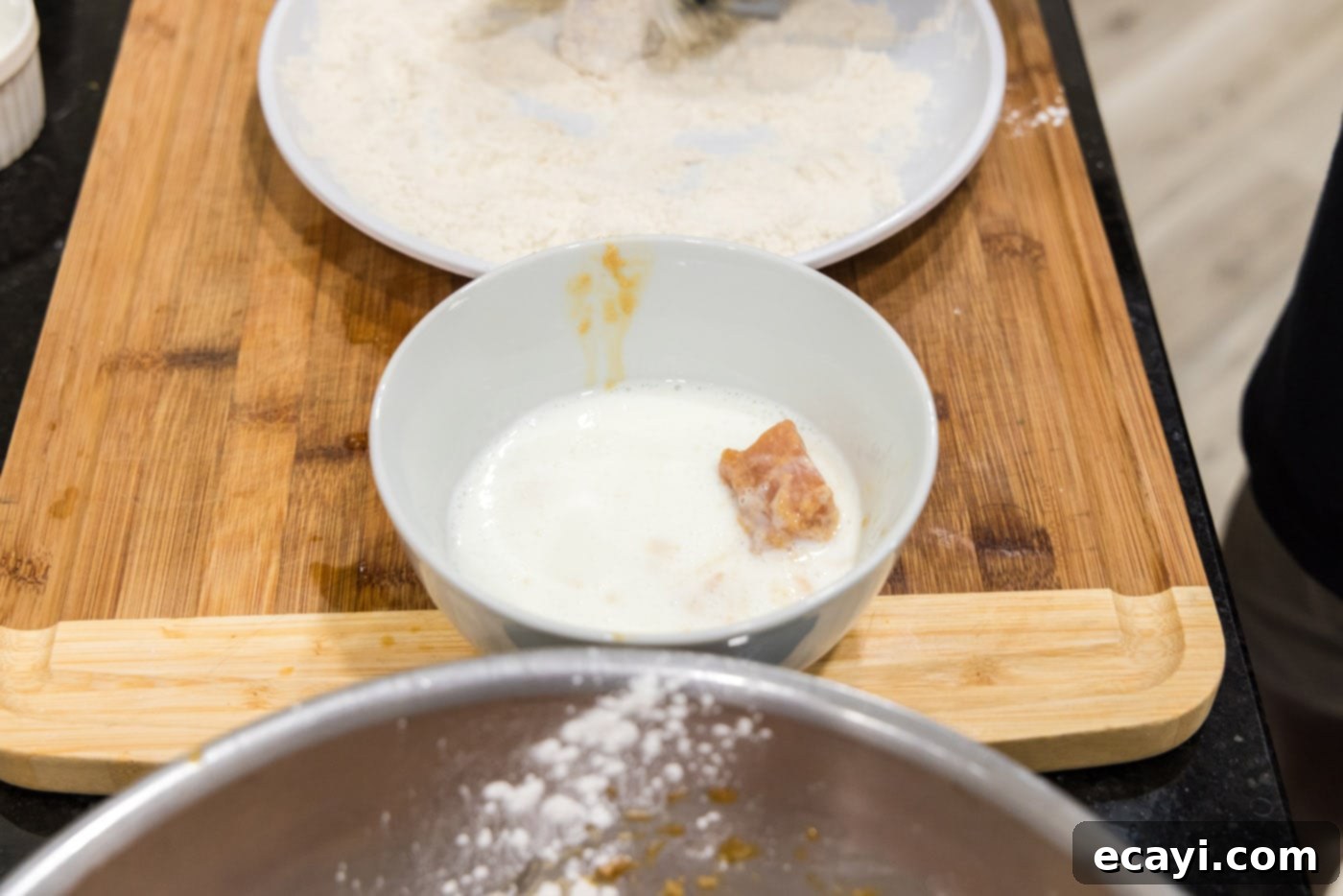
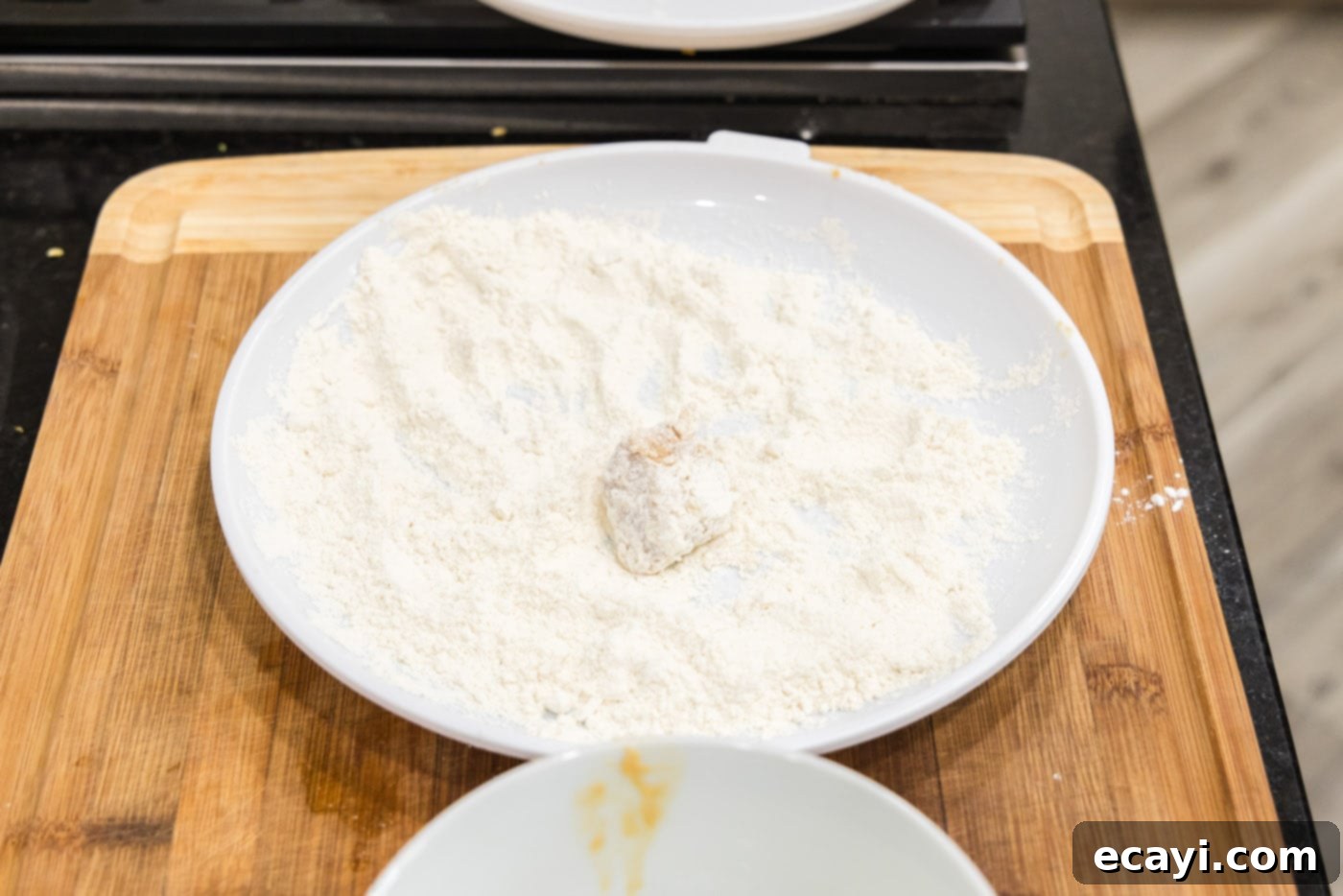

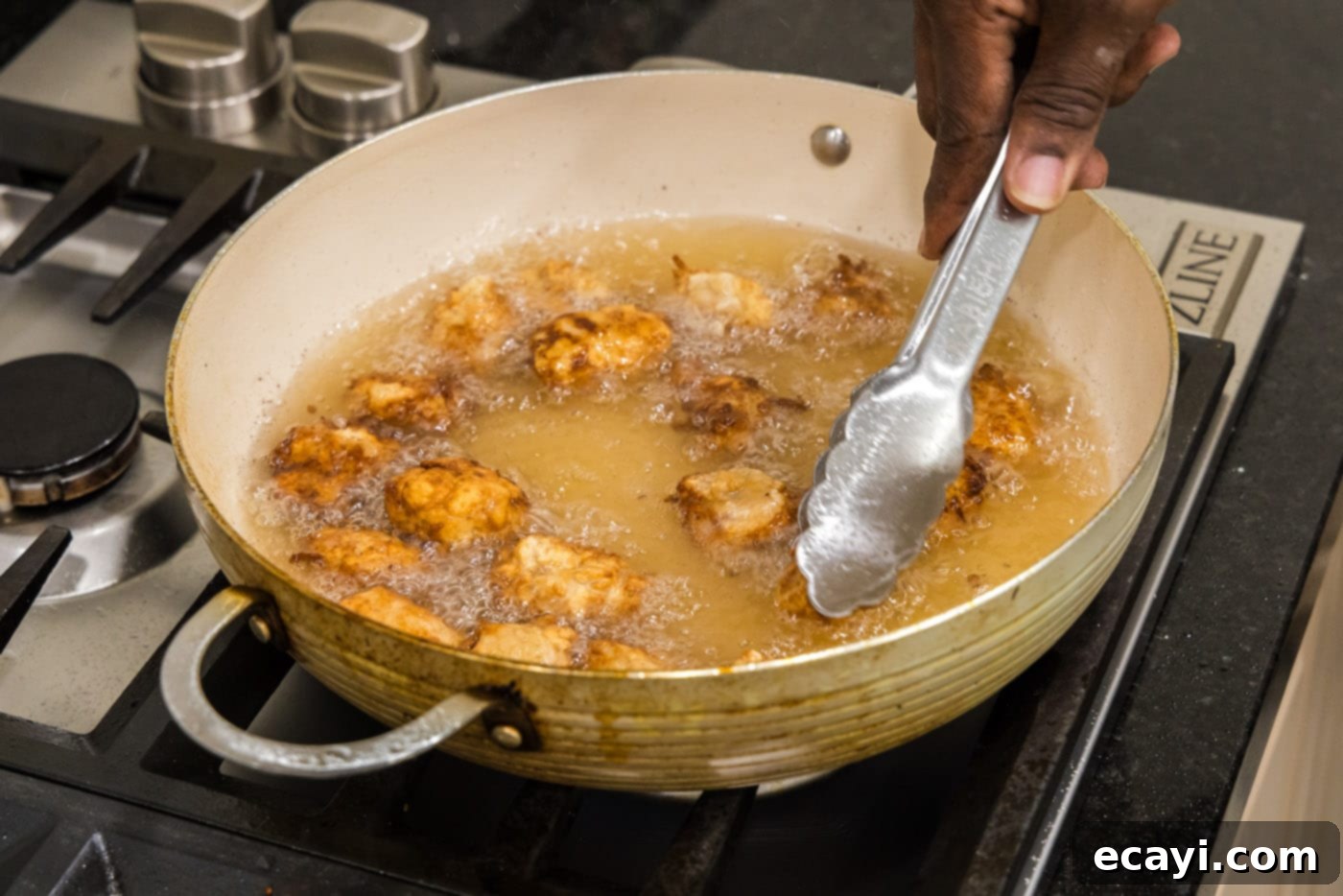

The Final Stir-Fry
- Sauté the Vegetables: Heat 2 tablespoons of olive oil in a large wok or a wide, deep skillet over medium-high heat until it begins to shimmer. Add the chopped onion, green bell pepper, and red bell pepper to the hot wok. Stir-fry for 2-3 minutes, just until the vegetables are crisp-tender but still retain their vibrant color and a slight bite. Avoid overcooking them.
- Add Half the Sauce: Pour about half of your prepared sweet and sour sauce directly into the wok with the stir-fried vegetables. Stir to combine, letting the sauce coat the vegetables lightly.
- Combine and Finish: Add the crispy cooked pork pieces to the wok. Introduce the pineapple chunks, then drizzle in more of the sweet and sour sauce to your liking. Gently toss all the ingredients together until the pork, vegetables, and pineapple are thoroughly coated in the luscious sauce. Heat through for another minute or two, ensuring everything is warm and the sauce is bubbling lightly. You may have a little extra sauce leftover, which is perfect for serving on the side.
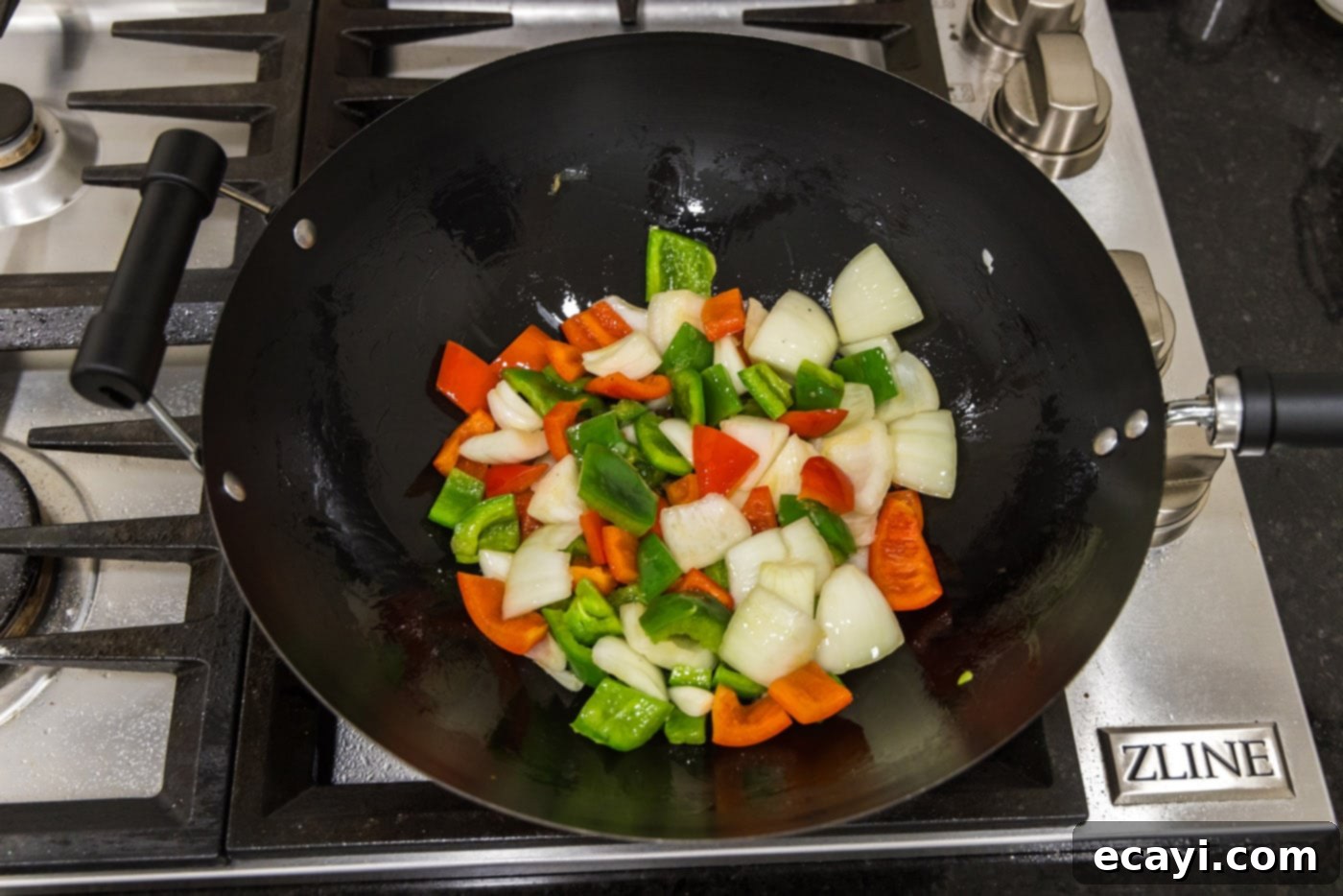
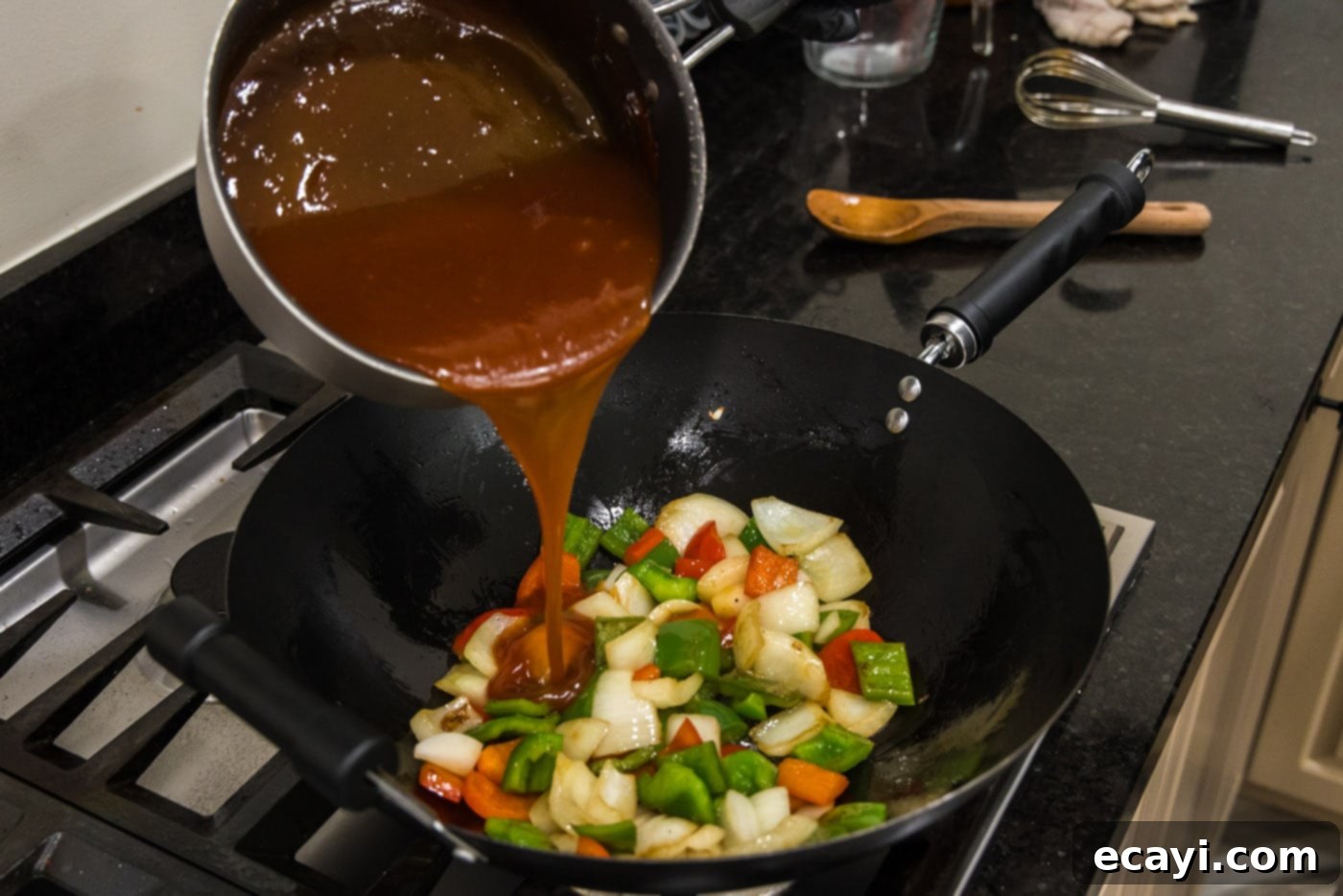
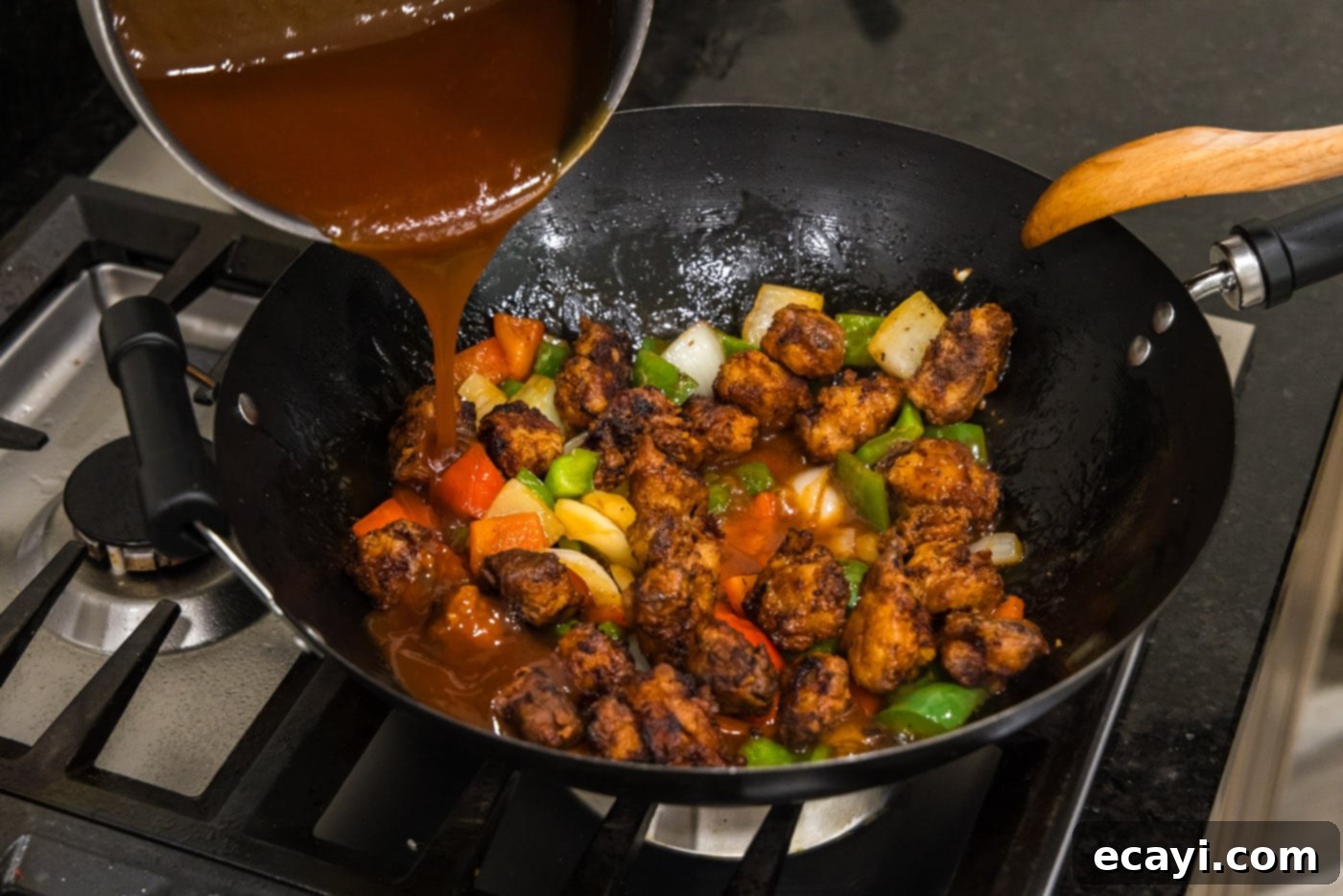
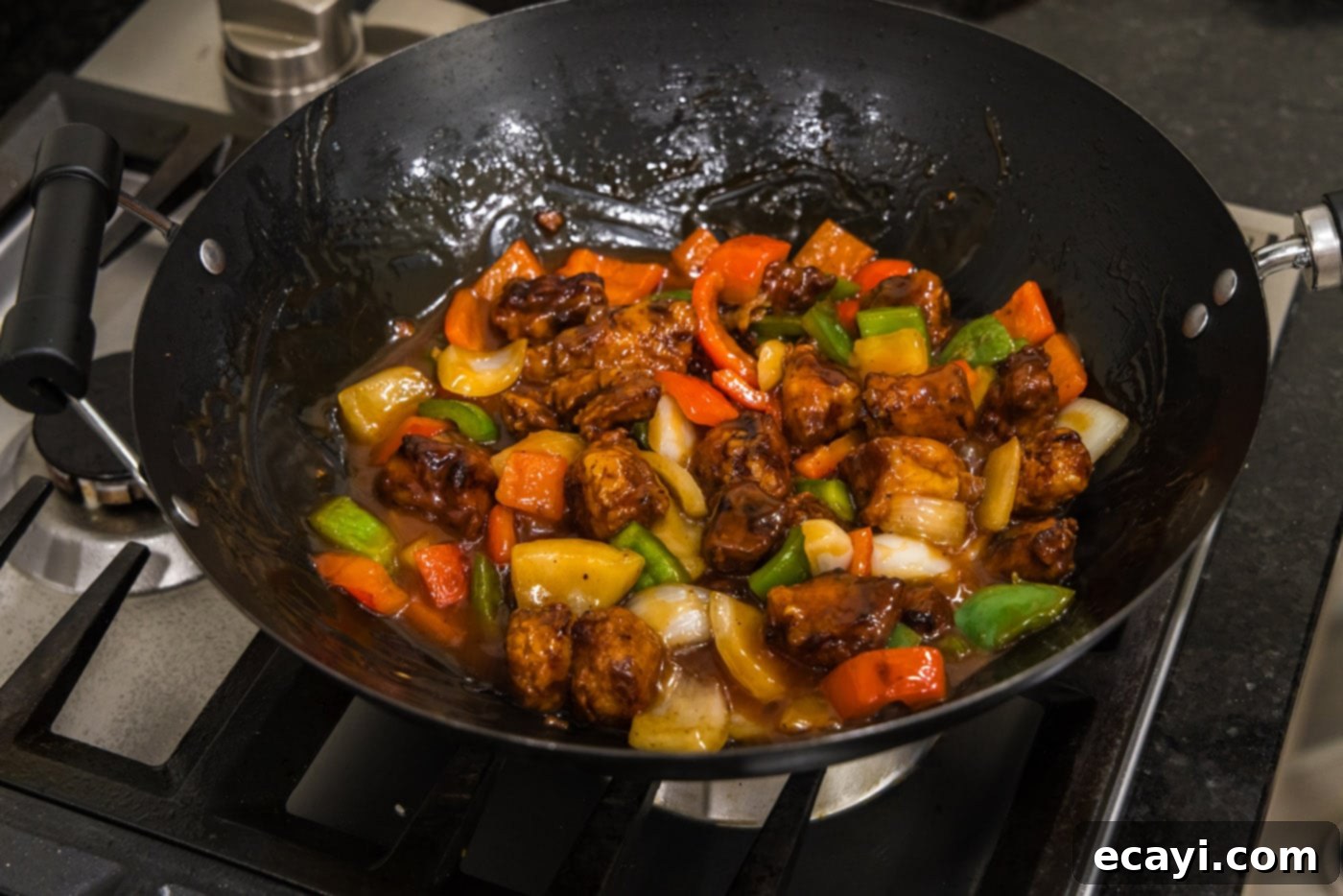
Frequently Asked Questions & Expert Tips for Perfect Sweet and Sour Pork
Here are some common questions and expert advice to help you master this delicious sweet and sour pork recipe:
For the best texture, sweet and sour pork is truly at its peak when enjoyed immediately after preparation. However, if you do have leftovers, they can be stored in an airtight container in the refrigerator for up to 3 days. The breading will inevitably soften, but the flavors will still be delicious. To reheat, you can use a microwave or gently warm it in a skillet on the stovetop over medium heat until heated through.
Achieving and maintaining crispiness in sauced dishes is a common challenge. Once breaded items like our pork come into contact with sauce, especially a thick, sticky one like sweet and sour, the breading will naturally begin to soften. This recipe aims for the perfect balance of crispy exterior and saucy interior, which is why it’s best served right away. To maximize initial crispiness: ensure your oil is at the correct temperature (325°F) for frying, avoid overcrowding the pan, and drain the fried pork on a wire rack to prevent it from sitting in excess oil. If you prefer a crunchier texture, you can add the pork to the sauce right before serving.
While deep-frying yields the most traditional and crispy result, you can certainly bake the pork for a lighter version. After breading, place the pork pieces on a baking sheet lined with parchment paper and lightly sprayed with cooking spray. Bake at 400°F (200°C) for 15-20 minutes, flipping halfway through, until golden brown and cooked through. The texture will be less crispy than fried pork but still delicious.
The consistency of your sweet and sour sauce is key. If your sauce is too thin, create another small cornstarch slurry (1 teaspoon cornstarch mixed with 1 tablespoon cold water) and slowly whisk it into the simmering sauce until it reaches the desired thickness. If your sauce becomes too thick, you can thin it out by adding a small amount of pineapple juice or water, one tablespoon at a time, until it loosens up. Always adjust gradually.

Serving Suggestions to Complete Your Meal
Sweet and sour pork is a meal in itself, but it truly shines when paired with simple accompaniments that soak up its glorious sauce. The most classic pairing is a generous bed of fluffy white rice, which provides a neutral canvas for the rich flavors. For an added touch of freshness and visual appeal, consider garnishing your finished dish with a sprinkle of thinly sliced green onions (scallions) and a dash of sesame seeds. These not only add color but also a subtle aromatic and nutty crunch.
Beyond white rice, you could serve it with egg fried rice for a heartier meal, or even alongside some lo mein noodles for another takeout favorite combination. For a more vegetable-focused side, a simple stir-fried bok choy or steamed broccoli would complement the dish beautifully, adding more greens and balancing the meal. Don’t forget, if you have any extra sweet and sour sauce, it makes an excellent dipping sauce or an extra drizzle over your rice!
Explore More Delicious Stir-Fry Recipes
If you’ve enjoyed creating this sweet and sour pork, you’ll love exploring other stir-fry and Asian-inspired dishes that bring vibrant flavors and quick cooking to your kitchen. Expand your repertoire with these equally delicious recipes:
- Orange Chicken
- Pork Fried Rice
- Sweet and Sour Shrimp
- Sweet and Sour Chicken
Each of these recipes offers a unique twist on the stir-fry concept, ensuring there’s always something new and exciting to cook for your family and friends.
I love to bake and cook and share my kitchen experience with all of you! Remembering to come back each day can be tough, that’s why I offer a convenient newsletter every time a new recipe posts. Simply subscribe and start receiving your free daily recipes!

Sweet and Sour Pork
IMPORTANT – There are often Frequently Asked Questions within the blog post that you may find helpful. Simply scroll back up to read them!
Print It
Pin It
Rate It
Save ItSaved!
Ingredients
- 1 ½ pounds boneless pork loin center cut roast
Marinade
- 1 cup chopped onion
- 1 teaspoon minced garlic
- 1 teaspoon minced ginger
- ¼ cup soy sauce
Sweet and Sour Sauce
- 4 Tablespoons honey
- 3 Tablespoons soy sauce
- 2 ½ Tablespoons tomato paste
- 1 cup pineapple juice
- 3 Tablespoons rice vinegar
- 1 Tablespoon cornstarch
- ¼ cup water
Batter for Breading
- 1 cup all purpose flour divided
- ½ cup buttermilk
- vegetable oil for frying
Stir Fry Vegetables
- 2 Tablespoons olive oil
- 1 medium onion chopped into large chunks
- 1 large green bell pepper chopped into large chunks
- 1 large red bell pepper chopped into large chunks
- 1 cup pineapple chunks
Things You’ll Need
-
Wok
-
immersion blender
-
Saucepan
-
Tongs
Before You Begin
- We used pork loin for this recipe. Pork neck or pork shoulder will also work. Try to cut the pork into similar sized cubes for even cooking.
- Ensure all vegetables are cut to a similar size for even stir-frying and a visually appealing dish.
- Read through all instructions before you start cooking to ensure a smooth process.
Instructions
Marinate the Meat
-
Cut the boneless pork loin roast into uniform, bite-sized cubes and place them in a large mixing bowl.
-
In an immersion blender container, combine chopped onion, minced garlic, minced ginger, and soy sauce. Blend until the mixture is completely smooth and no chunks remain.
-
Pour the marinade over the pork in the mixing bowl. Use gloved hands to toss and thoroughly coat all the meat pieces. Cover the bowl with plastic wrap and refrigerate for 30 minutes to allow the flavors to penetrate.
Preparing the Sauce
-
Line a baking sheet with paper towels and place a wire cooling rack over the top; this will be for draining the fried pork.
-
In a medium saucepan, combine all sauce ingredients (honey, soy sauce, tomato paste, pineapple juice, rice vinegar), reserving the cornstarch and water. Whisk occasionally over medium-high heat until the sauce begins to bubble. In a small separate bowl, create a slurry by whisking the cornstarch and water until smooth. Pour the slurry into the bubbling sauce, whisking continuously, and cook until the sauce thickens to a desired sticky consistency. Turn off the heat and set aside.
Breading and Frying the Pork
-
Sprinkle 2 tablespoons of the all-purpose flour over the marinated pork in the large mixing bowl. Use gloved hands to toss the pork, ensuring it is lightly coated.
-
Set up a breading station: place the buttermilk in a medium bowl and the remaining flour on a separate plate or shallow dish.
-
Dip each piece of pork into the buttermilk, letting excess drip off, then dredge it thoroughly in the flour, pressing gently to ensure a complete and even coating. Repeat for all pork pieces.
-
Heat vegetable oil in a deep pot or Dutch oven over medium-high heat until it reaches 325°F (160°C).
-
Carefully add the breaded pork, one piece at a time, to the hot oil. Fry in batches for 3-4 minutes, or until the pork is golden brown and cooked through. Use tongs to turn the pieces over halfway for even cooking.
-
Transfer the fried pork pieces to the prepared wire cooling rack to drain excess oil, keeping them crispy.
Stir Fry and Serve
-
Add 2 tablespoons of olive oil to a wok or large skillet over medium-high heat until shimmering. Add the chopped onion, green bell pepper, and red bell pepper to the pan and stir-fry for 2-3 minutes, until crisp-tender.
-
Pour about half of the prepared sweet and sour sauce into the wok with the vegetables, stirring to coat.
-
Add the cooked pork pieces and pineapple chunks to the wok. Add more sauce to your preference, gently tossing to ensure all ingredients are coated. Heat through for an additional minute or two, ensuring the dish is piping hot. Serve immediately over rice and enjoy!
Expert Tips & FAQs
- Although this dish is best served right away for optimal crispiness, you can store any leftovers in an air-tight container in the refrigerator for up to 3 days.
- Any leftover sweet and sour sauce can be stored separately in an air-tight container or jar in the refrigerator for up to 2 months and is great on other proteins like chicken or shrimp.
- To ensure even cooking and browning of your pork, make sure to cut the pork into uniform, bite-sized cubes.
- For maximum crispiness, make sure your frying oil is at the correct temperature (325°F) and avoid overcrowding the pan during frying.
Nutrition
The recipes on this blog are tested with a conventional gas oven and gas stovetop. It’s important to note that some ovens, especially as they age, can cook and bake inconsistently. Using an inexpensive oven thermometer can assure you that your oven is truly heating to the proper temperature. If you use a toaster oven or countertop oven, please keep in mind that they may not distribute heat the same as a conventional full sized oven and you may need to adjust your cooking/baking times. In the case of recipes made with a pressure cooker, air fryer, slow cooker, or other appliance, a link to the appliances we use is listed within each respective recipe. For baking recipes where measurements are given by weight, please note that results may not be the same if cups are used instead, and we can’t guarantee success with that method.
